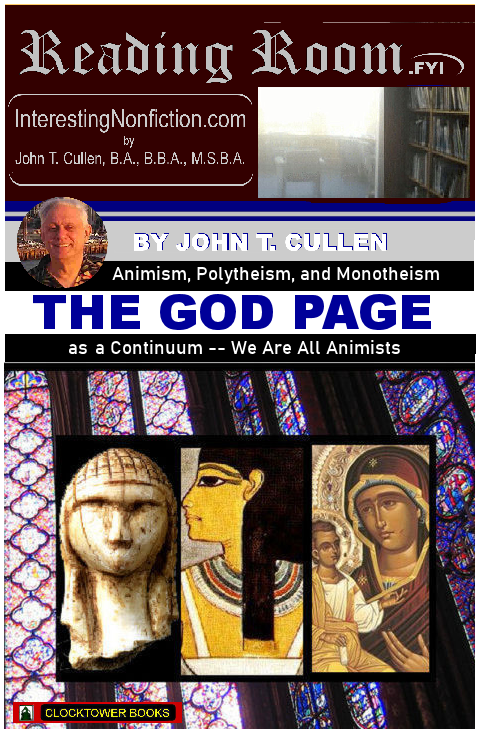|
The God Page: We Are All Animists
Essay on Religion by John T. Cullen
As many people suspect, religions around the world have more in common than not. This article explores the commonalities of three great historic expressions of spirituality: Animism, Polytheism, and Monotheism. Surprisingly—or not—a closer analysis shows that all three are essentially rearrangements of the same deck chairs on a Titanic (history filled with sectarian bloodshed) that can be avoided through understanding. This article introduces a fourth modality of individual freedom from what amounts to bad leadership. We can free ourselves from fear and oppression when we resist demagogues and other bad leaders who use religion and patriotism to rally gullible people for their own selfish, short-term purposes. The freedom is there—if we educate ourselves, and think for ourselves.
From the archaic period through the end of her Western empire, Rome was a continuum of three great modalities defining all faiths in all ages: animism, polytheism, monotheism. The experience of Rome leads us to a broader understanding of the human spiritual experience, and hope for a better future through understanding and tolerance brought about by eliminating lies, fear, ignorance that are used by button-pushers to drive masses of human beings to bloodshed and slaughter for which ultimately there is no gain or reason other than the selfish, short-term motives of demagogues and manipulators.
After centuries of fear, ignorance, and hatred leading to bloodshed and tragedy in the name of religion, it is time to put our knives and guns away (and bombs, you modern loonies in the Miserable East) and come together at the altar of peace and understanding.
This personal essay looks impartially at the three sweeping modalities, and offers a final, surprising opportunity for modern times. The author takes no sectarian sides—readers of all persuasions are welcome. Only the intolerant will be offended. Seekers after truth will have a feast. And, as always, this is just a beginning for further study and contemplation.
Author John T. Cullen's understanding has deepened over years of research for an upcoming major book--A Walk in Ancient Rome, first ever virtual tour of the imperial capital in the age of Constantine (c330 CE). The author followed the culture's development from the Iron Age and the mythic founder Romulus (c753 BCE) to its twilight some thirteen centuries later as the European Middle Ages set in. Over this vast span of time, the author gained much insight about the religious development of the Romans as a template for general human development. It becomes ultimately a long saga of sectarianism and tragedy that can be broken today through understanding and tolerance.
Using Rome as a template, he broadened his reading and studies to humankind as a whole, with scholars ranging from Joseph Campbell and Karen Armstrong to Paul Veyne and W. H. D. Rouse and more. His history and literary reading is voluminous, including Paul Johnson, Cicero, Livy, Varro, Herodotus, Samuel Ball Platner, Thomas Ashby, L. Richardson jr., Fernand Braudel, David Abulafia, and many more. The author's approach is macrohistorical in the sense that he considers 'all history is context' and he admires the Annales school of Braudel.
Combining that understanding with his studies of human history and prehistory for these articles, the author is able to explain a synthesis of the world's religious history, and offer relevant inspirations for our new global age. This article takes a detailed look at what's been right and wrong, what's been ugly and beautiful, and comes up with a Fourth Modality that does not require us to give up our cherished background, nor our personal choice of beliefs. If anything, it only requires our faith (whatever it may be in form and nomenclature), and ourselves, to live up to their best promises. In return, we may find freedom from fear, and a peace that surpasses understanding.

TOP
|
|
|
No print edition currently available. Kindle e-book only.
|
Browse or Buy at Amazon
The book linked at left is an e-book edition to browse; or buy & download from Amazon for your Kindle reader.
The middle link is for the corresponding print edition. Most of these are standard 6x9"; a few have added trim sizes available (5x8"). More info at Amazon.com.
Most print editions are also available at Barnes & Noble online; or call/visit your local bookstore to order.
|

|